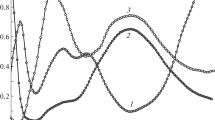Abstract
In an earlier publication [4] the possibility of the Chromatographic separation of structurally isomeric metal chelates was mentioned; this is dealt with here in more detail. Further the separation of 1:2 mixed complexes from azo dyes and 1:2 metal-complex mixtures by thin-layer chromatography (TLC) on polyamide is described. In certain circumstances it is possible to distinguish between 1:2 metal-complex dyes with sulphonamide or alkylsulphonyl groups and those without these substituents by TLC on silica gel. The TCL methods described allow-when correctly interpreted-an unambiguous distinction between structurally isomeric metal complexes of the 1:1 and 1:2 series, and mixed complexes and mixtures of complexes of the 1:2 metal-chelate type of unsulphonated o,o′-dihydroxyazo compounds.
Symmetrical o,o′-dihydroxyazo compounds, such as 2,2′-dihydroxy-5,5′-dimethylazobenzene(7), are suitable as complex-formers for heavy-metal ions, allowing the separation of the latter as their coloured chelates with aid of TLC. Structural isomers are excluded because of the molecular symmetry, so that the results are unambiguous.
Zusammenfassung
In einer früheren Veröffentlichung [4] ist auf die Möglichkeit der chromatographischen Trennung strukturisomerer Metallchelate hingewiesen worden; sie soll hier ausführlicher dargestellt werden. Weiterhin wird die Trennung von 1:2-Mischkomplexen von Azofarbstoffen und von 1:2-Metallkomplex-Mischungen durch Dünnschicht-Chromatographie (DC) an Polyamid beschrieben. Unter bestimmten Voraussetzungen kann durch DC an Kieselgel zwischen 1:2-Metallkomplexfarbstoffen mit Sulfonsäureamid- bzw. Alkylsulfongruppen und solchen ohne diese Substituenten unterschieden werden. Die beschriebenen DC-Methoden ermöglichen bei richtiger Interpretation eine eindeutige Unterscheidung zwischen strukturisomeren Metallkomplexen der 1:1- und 1:2-Reihe, sowie Mischkomplexen und Komplexmischungen vom 1:2-Metall-chelattyp unsulfierter o,o′-Dihydroxyazoverbindungen.
Symmetrische o,o′-Dihydroxyazoverbindungen, wie z.B. das 2,2′-Dihydroxy-5,5′-dimethyl-azobenzol(7), sind geeignete Komplexbildner für Schwermetallkationen, um diese als farbige Chelate mit Hilfe der DC voneinander zu trennen. Strukturisomere sind wegen der Molekülsymmetrie ausgeschlossen, so daß die Ergebnisse eindeutig sind.
Similar content being viewed by others
Literatur
DOS 1901256 der BASF vom 11. 1. 1969
DRP 474997 der I. G. Ludwigshafen vom 29. 8. 1926 (Friedländer16, 968)
DRP 715082 der I. G. Ludwigshafen vom 20. 8. 1938
Pfitzner, H.: Angew. Chem.84, 351–352 (1972) Angew. Chem. Internat. Edit.11, No. 4, 312 (1972)
Schetty, G.: Helv. Chim. Acta53, 1437–1459 (1970)
Zusammenfassende Darstellungen u. a. in „Neue Metallkomplexfarbstoffe, Struktur und färberische Eigenschaften“ von H. Baumann u. H. R. Hensel, Fortschr. Chem. Forsch., Bd. 7, Heft 4. Berlin-Heidelberg-New York: Springer 1967; und K. Venkataraman: The chemistry of synthetic dyes, Vol. III, Chapter VII: The chemistry of metal complex dyestuffs, von R. Price. Acad. Press 1970
Author information
Authors and Affiliations
Rights and permissions
About this article
Cite this article
Pfitzner, H., Schweppe, H. 1:1- und 1:2-Metallchelate unsulfierter o,o′-Dihydroxyazoverbindungen. Eine dünnschicht-chromatographische Untersuchung. Z. Anal. Chem. 268, 337–342 (1974). https://doi.org/10.1007/BF01155022
Received:
Issue Date:
DOI: https://doi.org/10.1007/BF01155022




